Factors That Control the Reservoir Quality of the Carboniferous–Permian Tight Sandstones in the Shilounan Block, Ordos Basin
Abstract
:1. Introduction
2. Geological Setting
2.1. Structural Characteristics and Stratigraphy
2.2. Sedimentary Facies and Sand Body Distribution
3. Sampling and Methodology
4. Results
4.1. Petrological Characteristics
4.2. Porosity and Permeability
4.3. Pore System
4.3.1. Pore Type
4.3.2. Pore Structure
5. Discussion
5.1. Sedimentation Controls on Reservoir Quality
5.2. Diagenetic Controls on Reservoir Quality
5.2.1. Diagenesis Type
5.2.2. Influence of the Diagenesis Type on the Porosity
5.3. Pore Structure Controls on the Reservoir Quality
5.4. Evaluation of Sandstone Reservoirs
| Parameters | Type I | Type II | Type III | |
|---|---|---|---|---|
| Depositional Feature | Single-layer sandstone thickness/m | >8 | 3–8 | 3< |
| Sandstone type | Coarse- to medium-grained quartz sandstone, lithic quartz sandstone, with low interstitial content | Medium- to fine-grained quartz lithic sandstone, lithic sandstone, medium to low interstitial content, kaolinite is the predominant clay mineral | Fine-grained lithic sandstone, with high content of fillings, mainly carbonates and clay minerals | |
| Sand body type | Channel sand body | Channel sand body, underwater distributary channel sands | Underwater distributary channel sands | |
| Physical Property | Porosity/% | >10 | 5–10 | 5< |
| Permeability/mD | >0.5 | 0.1–0.6 | 0.1< | |
| Pore Structure | Pore type | Intergranular and dissolution pores | Intergranular and dissolution pores | Intercrystalline pores |
| Pore-Throat | Mesopore-fine throat, moderately sorted | Fine-micro throat, poorly sorted | Micro-throat, poorly sorted | |
| Displacement pressure | Low | Medium | High | |
| Average throat size/μm | >0.4 | 0.2–0.4 | 0.2< | |
| Reservoir Properties | High quality | Good | Average and lower | |
6. Conclusions
Author Contributions
Funding
Data Availability Statement
Acknowledgments
Conflicts of Interest
References
- Nelson, P.H. Pore-throat sizes in sandstones, tight sandstones, and shales. AAPG Bull. 2009, 93, 329–340. [Google Scholar] [CrossRef]
- Zou, C.N.; Zhu, R.K.; Wu, S.T.; Yang, Z.; Tao, S.Z.; Yuan, X.J.; Hou, L.H.; Yang, H.; Xu, C.C.; Li, D.H.; et al. Types, characteristics, genesis and prospects of conventional and unconventional hydrocarbon accumulations: Taking tight oil and tight gas in China as an instance. Acta Pet. Sin. 2012, 33, 173–187. [Google Scholar]
- Nabawy, B.S.; Abd El Aziz, E.A.; Ramadan, M.; Shehata, A.A. Implication of the micro- and lithofacies types on the quality of a gas-bearing deltaic reservoir in the Nile Delta, Egypt. Sci. Rep. 2023, 13, 8873. [Google Scholar] [CrossRef] [PubMed]
- Zou, C.N.; Yang, Z.; Tao, S.Z.; Yuan, X.J.; Zhu, R.K.; Hou, L.H.; Pang, Z.L. Continuous hydrocarbon accumulation over a large area as a distinguishing characteristic of unconventional petroleum: The Ordos Basin, North-Central China. Earth Sci. Rev. 2013, 126, 358–369. [Google Scholar] [CrossRef] [Green Version]
- Qu, X.; Sun, W.; Lei, Q.; Huang, H.; Huo, L. Study on saturation of movable fluid in the low-permeability sandstone reservoirs of Huaqing Oilfeld and its influencing factors. J. Xi’an Shiyou Univ. (Nat. Sci. Ed.) 2016, 31, 93–98. [Google Scholar]
- Liu, M.J.; Xiong, C. Diagenesis and reservoir quality of deep-lacustrine sandy-debris-flow tight sandstones in Upper Triassic Yanchang Formation, Ordos Basin, China: Implications for reservoir heterogeneity and hydrocarbon accumulation. J. Pet. Sci. Eng. 2021, 202, 108548. [Google Scholar] [CrossRef]
- Yang, H.; Fu, J.H.; Liu, X.S.; Meng, P.L. Accumulation conditions and exploration and development of tight gas in the Upper Paleozoic of the Ordos Basin. Pet. Explor. Dev. 2012, 39, 295–303. [Google Scholar] [CrossRef]
- Schmid, S.; Worden, R.H.; Fisher, Q.J. Diagenesis and reservoir quality of the sherwood sandstone (triassic), corrib feld, slyne basin, west of Ireland. Mar. Pet. Geol. 2004, 21, 299–315. [Google Scholar] [CrossRef]
- Lai, J.; Wang, G.; Ran, Y.; Zhou, Z.; Cui, Y. Impact of diagenesis on the reservoir quality of tight oil sandstones: The case of Upper Triassic Yanchang Formation Chang 7 oil layers in Ordos Basin, China. J. Pet. Sci. Eng. 2016, 145, 54–65. [Google Scholar] [CrossRef]
- Abdel-Fattah, M.I.; Sen, S.; Abuzied, S.M.; Abioui, M.; Radwan, A.E.; Benssaou, M. Facies analysis and petrophysical investigation of the late miocene abu madi sandstones gas reservoirs from offshore baltim east feld (nile delta, Egypt). Mar. Pet. Geol. 2022, 137, 105501. [Google Scholar] [CrossRef]
- Radwan, A.E.; Husinec, A.; Benjumea, B.; Kassem, A.A.; Abd El Aal, A.K.; Hakimi, M.H.; Thanh, H.V.; Abdel-Fattah, M.I.; Shehata, A.A. Diagenetic overprint on porosity and permeability of a combined conventional-unconventional reservoir: Insights from the Eocene pelagic limestones, Gulf of Suez, Egypt. Mar. Pet. Geol. 2022, 146, 105967. [Google Scholar]
- Dong, S.; Zeng, L.; Lyu, W.; Xia, D.; Liu, G.; Wu, Y.; Du, X. Fracture identification and evaluation using conventional logs in tight sandstones: A case study in the Ordos Basin, China. Energy Geosci. 2020, 1, 115–123. [Google Scholar] [CrossRef]
- Wei, J.X.; Chen, S.; Gu, Y.; Zhang, H.; Yin, S.; Yuan, H. Diagenesis and reservoir classifcation criteria for Jurassic continental sandstone oil reservoir in the western Ordos Basin, China. Geol. J. 2021, 56, 3868–3882. [Google Scholar] [CrossRef]
- Zhao, Z.; Liu, Z.; He, F.Q.; Zhang, W.; Li, M.; Hou, Y.J.; Fu, S.; Zhu, M.L. An improved time–depth dual porosity evolution model and a new parameter for tight sandstone reservoir quality evaluation. J. Asian Earth Sci. 2023, 252, 105684. [Google Scholar] [CrossRef]
- Tang, S.L.; Tang, D.Z.; Liu, S.M.; Li, S.; Tang, J.C.; Wang, M.F.; Zhang, A.B.; Pu, Y.F. Multiscale pore characterization of coal measure reservoirs and gas storage and transport behavior in Yanchuannan gas field of China. AAPG Bull. 2022, 106, 2387–2415. [Google Scholar] [CrossRef]
- Zhang, A.B.; Chen, S.D.; Tang, D.Z.; Tang, S.L.; Zhang, T.Y.; Pu, Y.F.; Sun, B. The Study on Diagenetic Characteristics of Coal Measures Sandstone Reservoir in Xishanyao Formation, Southern Margin of the Junggar Basin. Energies 2022, 15, 5499. [Google Scholar] [CrossRef]
- Worden, R.H.; Mayall, M.; Evans, I.J. The effect of ductile-lithic sand grains and quartz cement on porosity and permeability in Oligocene and lower Miocene clastics, South China Sea: Prediction of reservoir quality. Am. Assoc. Pet. Geol. Bull. 2000, 84, 345–359. [Google Scholar]
- Liu, K.; Wang, R.; Shi, W.Z.; Travéb, A.; Martín-Martín, J.D.; Baqués, V.; Qi, R.; Lin, J.W.; Ye, H. Diagenetic controls on reservoir quality and heterogeneity of the Triassic Chang 8 tight sandstones in the Binchang area (Ordos Basin, China). Mar. Pet. Geol. 2022, 146, 105974. [Google Scholar] [CrossRef]
- Cai, Y. Study on the Relationship between Reservoir Evolution and Oil Accumulation Process of Chang 8 Tight Sandtone Oil Reservoir in Jiyuan Area, Ordos Basin. Ph.D. Thesis, Chang’an University, Xi’an, China, 2015. [Google Scholar]
- Liang, J.T.; Huang, W.H.; Wang, H.L.; Blum, M.J.; Chen, J.; Wei, X.L.; Yang, G.Q. Organic geochemical and petrophysical characteristics of transitional coalmeasure shale gas reservoirs and their relationships with sedimentary environments: A case study from the Carboniferous-Permian Qinshui Basin, China. J. Pet. Sci. Eng. 2020, 184, 106510. [Google Scholar] [CrossRef]
- Mansurbeg, H.; De Ros, L.F.; Morad, S.; Ketzer, J.M.; El-Ghali, M.A.K.; Caja, M.A.; Othman, R. Meteoric-water diagenesis in late Cretaceous canyou-fll turbidite reservoirs from the Espirito Santo Basin, eastern Brazil. Mar. Pet. Geol. 2012, 37, 7–26. [Google Scholar] [CrossRef]
- Yang, T.; Cao, Y.; Friis, H.; Liu, K.; Wang, Y.; Zhou, L.; Yuan, G.; Xi, K.; Zhang, S. Diagenesis and reservoir quality of lacustrine deep-water gravity-flow sandstones in the Eocene Shahejie Formation in the Dongying sag, Jiyang depression, eastern China. AAPG Bull. 2020, 104, 1045–1073. [Google Scholar] [CrossRef]
- Zhou, X.; He, Y.; Wang, J.; Li, S.; Ling, A. Characteristics of sandy debris flow reservoir from Chang 6 Formation in Ordos Basin. Sci. Technol. Eng. 2014, 14, 216–220, (In Chinese with English Abstract). [Google Scholar]
- Liao, J.; Xi, A.; Li, Z.; Liu, H.; Li, X.; Wanyan, R. Microscopic characterization and formation mechanisms of deepwater sandy-debris-flow and turbidity-current sandstones in a lacustrine basin: A case study in the Yanchang Formation of the Ordos Basin, China. Pet. Sci. 2018, 15, 28–40. [Google Scholar] [CrossRef] [Green Version]
- Xi, Z.D.; Tang, S.H.; Li, J.; Zhang, Z.Y.; Xiao, H.Q. Pore characterization and the controls of organic matter and quartz on pore structure: Case study of the Niutitang Formation of northern Guizhou Province, South China. J. Nat. Gas Sci. Eng. 2019, 61, 18–31. [Google Scholar] [CrossRef]
- Xi, Z.D.; Tang, S.H.; Lash, G.G.; Ye, Y.P.; Lin, D.L.; Zhang, B. Depositional controlling factors on pore distribution and structure in the lower Silurian Longmaxi shales: Insight from geochemistry and petrology. Mar. Pet. Geol. 2021, 130, 105114. [Google Scholar] [CrossRef]
- Lundegard, P.D. Sandstone porosity loss–a “big picture” view of the importance of compaction. J. Sediment. Res. 1992, 62, 250–260. [Google Scholar] [CrossRef]
- Paxton, S.T.; Szabo, J.O.; Ajdukiewicz, J.M.; Klimentidis, R.E. Construction of an intergranular volume compaction curve for evaluating and predicting compaction and porosity loss in rigid-grain sandstone reservoirs. Am. Assoc. Pet. Geol. 2002, 86, 2047–2067. [Google Scholar]
- Ehrenberg, S.N. Assessing the relative importance of compaction processes and cementation to reduction of porosity in sandstones: Discussion; compaction and porosity evolution of Pliocene sandstones, Ventura basin, California: Discussion. AAPG Bull. 1989, 73, 1274–1276. [Google Scholar]
- Taylor, K.G.; Gawthorpe, R.L.; Curtis, C.D.; Marshall, J.D.; Awwiller, D.N. Carbonate cementation in a sequence-stratigraphic framework: Upper Cretaceous sandstones, Book Cliffs, Uttah-Colorado. J. Sediment. Res. 2000, 70, 360–372. [Google Scholar] [CrossRef]
- Dutton, S.P. Calcite cement in Permian deep-water sandstones, Delaware Basin, west Texas: Origin, distribution, and effect on reservoir properties. AAPG Bull. 2008, 92, 765–787. [Google Scholar] [CrossRef]
- Xi, Z.D.; Tang, S.H.; Wang, J.; Yang, G.Q.; Li, L. Formation and development of pore structure in marine-continental transitional shale from northern China across a maturation gradient: Insights from gas adsorption and mercury intrusion. Int. J. Coal Geol. 2018, 200, 87–102. [Google Scholar] [CrossRef]
- Ma, B.; Cao, Y.; Jia, Y. Feldspar dissolution with implications for reservoir quality in tight gas sandstones: Evidence from the Eocene Es4 interval, Dongying Depression, Bohai Bay Basin, China. J. Pet. Sci. Eng. 2017, 150, 74–84. [Google Scholar] [CrossRef]
- Mahmi, O.; Dypvik, H.; Hammer, E. Diagenetic influence on reservoir quality evolution, examples from Triassic conglomerates/arenites in the Edvard Grieg feld, Norwegian North Sea. Mar. Pet. Geol. 2018, 93, 247–271. [Google Scholar] [CrossRef] [Green Version]
- Zhang, Y.; Jiang, S.; He, Z.; Wang, Y.; Chen, G. Characteristics of heterogeneous diagenesis and modifcation to physical properties of Upper Paleozoic tight gas reservoir in eastern Ordos Basin. J. Pet. Sci. Eng. 2022, 208, 109243. [Google Scholar] [CrossRef]
- Beard, D.C.; Weyl, P.K. Influence of texture on porosity and permeability of unconsolidated sand. AAPG Bull. 1973, 57, 349–369. [Google Scholar]
- Yang, J.Q.; Ji, Y.L.; Wu, H.; Meng, L.J. Diagenesis and Porosity Evolution of Deep Reservoirs in the Nanpu Sag: A case study of Sha 1 Member of the Paleogene in No. 3 structural belt. Acta Sedimentol. Sin. 2022, 40, 203–216. [Google Scholar]
- Wilson, J.C.; McBride, E.F. Compaction and porosity evolution of Pliocene sandstones, Ventura Basin, California. AAPG Bull. 1989, 73, 664–681. [Google Scholar]
- Wang, R.; Shi, W.; Xie, X.; Zhang, W.; Qin, S.; Liu, K.; Busbey Arthur, B. Clay mineral content, type, and their effects on pore throat structure and reservoir properties: Insight from the Permian tight sandstones in the Hangjinqi area, north Ordos Basin, China. Mar. Pet. Geol. 2020, 115, 104281. [Google Scholar] [CrossRef]
- Law, B.E. Basin-centered gas systems. AAPG Bull. 2002, 86, 1891–1919. [Google Scholar]
- Bell, D.; Kane, I.A.; Pontén, A.S.M.; Flint, S.S.; Hodgson, D.M.; Barrett, B.J. Spatial variability in depositional reservoir quality of deep-water channel-fll and lobe deposits. Mar. Pet. Geol. 2018, 98, 97–115. [Google Scholar] [CrossRef]
- Fic, J.; Pedersen, P.K. Reservoir characterization of a “tight” oil reservoir, the middle jurassic upper shaunavon member in the whitemud and eastbrook pools, SW saskatchewan. Mar. Pet. Geol. 2013, 44, 41–59. [Google Scholar] [CrossRef]
- Liu, D.; Sun, W.; Ren, D.; Li, C. Quartz cement origins and impact on storage performance in Permian Upper Shihezi Formation tight sandstone reservoirs in the northern Ordos Basin, China. J. Pet. Sci. Eng. 2019, 178, 485–496. [Google Scholar] [CrossRef]
- Ghanizadeh, G.; Clarkson, C.R.; Aquino, S.; Ardakani, O.H.; Sane, H. Petrophysical and geomechanical characteristics of Canadian tight oil and liquid-rich gas reservoirs: I. Pore network and permeability characterization. Fuel 2015, 153, 664–681. [Google Scholar] [CrossRef]
- Li, Z.; Wu, S.; Xia, D.; He, S.; Zhang, X. An investigation into pore structure and petrophysical property in tight sandstones: A case of the Yanchang Formation in the southern Ordos Basin, China. Mar. Pet. Geol. 2018, 97, 390–406. [Google Scholar] [CrossRef]
- Sakhaee-Pour, A.; Bryant, S.L. Effect of pore structure on the producibility of tightgas sandstones. AAPG Bull. 2014, 98, 663–694. [Google Scholar] [CrossRef]
- Christopher, B.; Kuiwu, L.; Oswald, G. Diagenesis and reservoir properties of the permian ecca group sandstones and mudrocks in the eastern cape province, South Africa. Minerals 2017, 7, 88. [Google Scholar]
- Enayati-Bidgoli, A.; Saemi, E. Effects of late diagenesis on primary reservoir quality of a quartz arenite unit: A case study from the lower Cretaceous successions of SW Iran. Pet. Sci. 2019, 16, 267–284. [Google Scholar] [CrossRef] [Green Version]


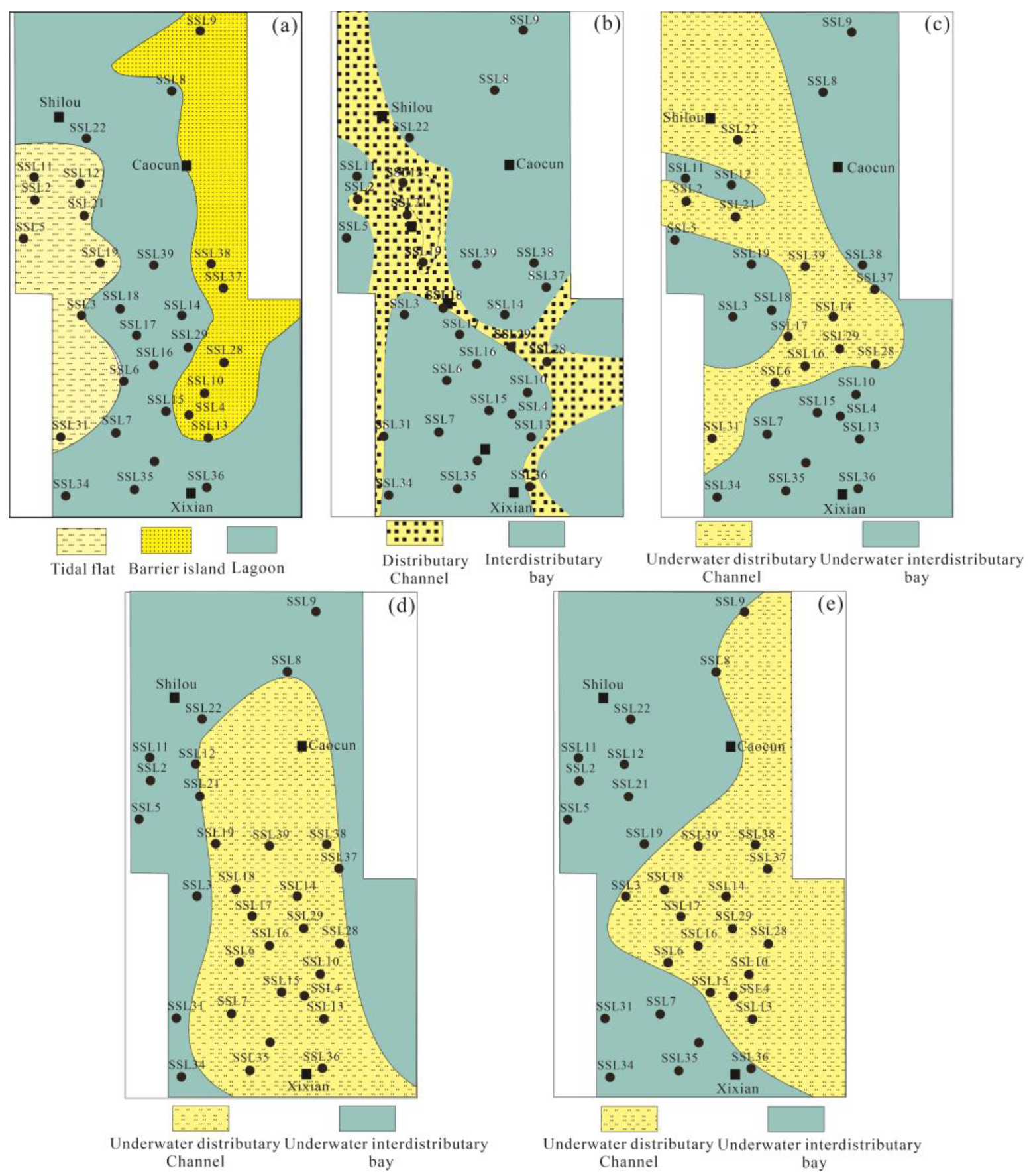
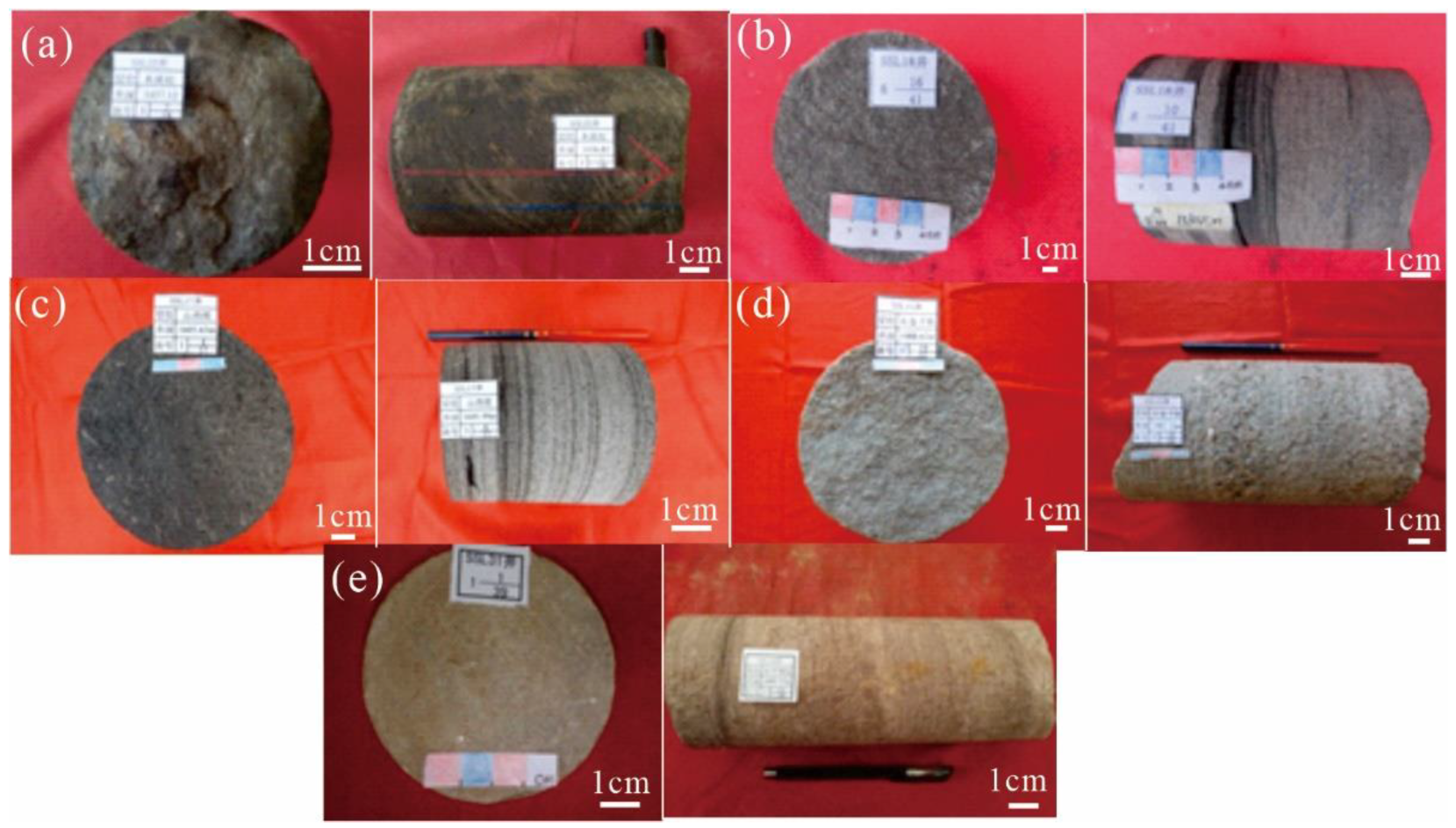


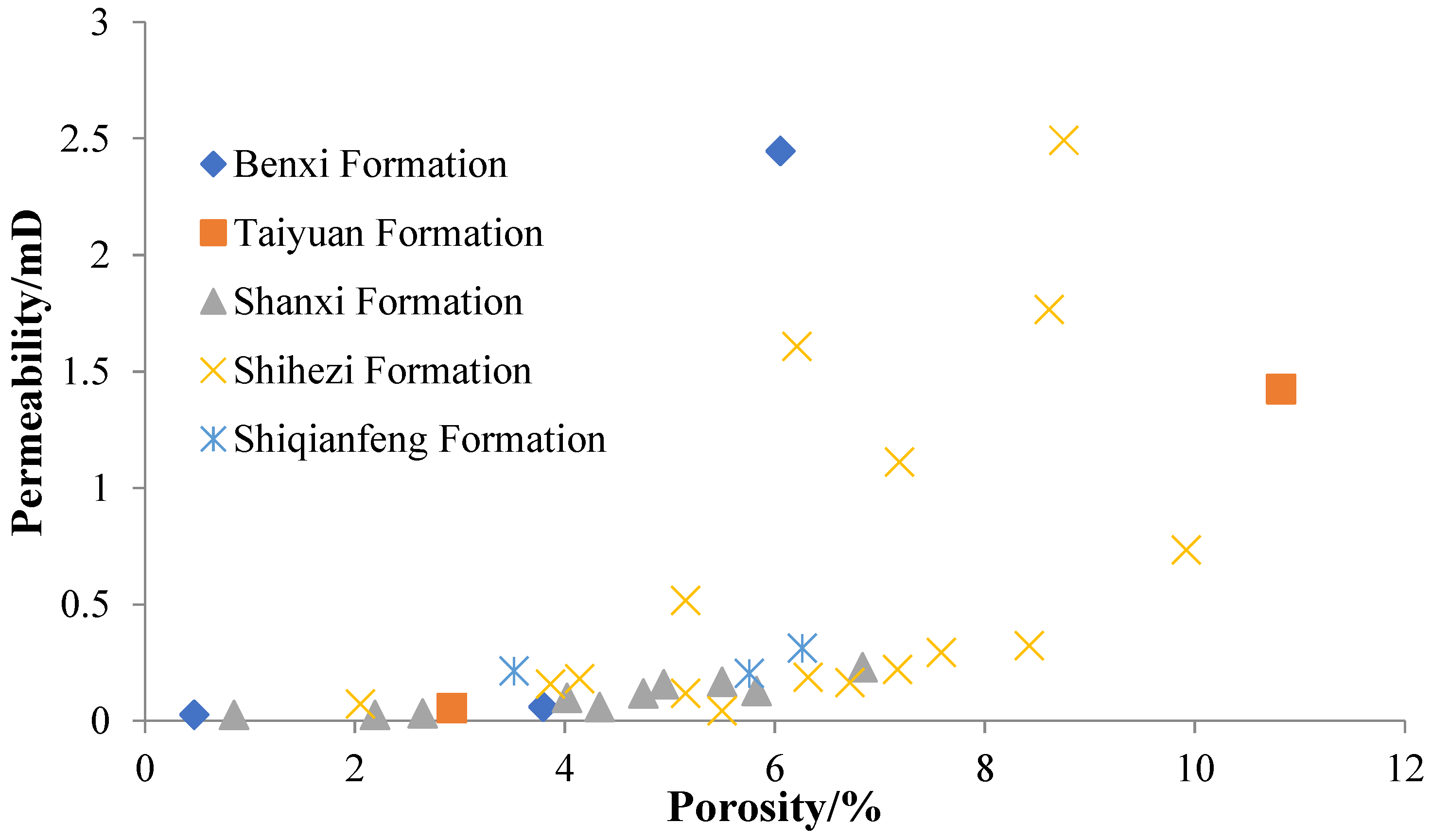
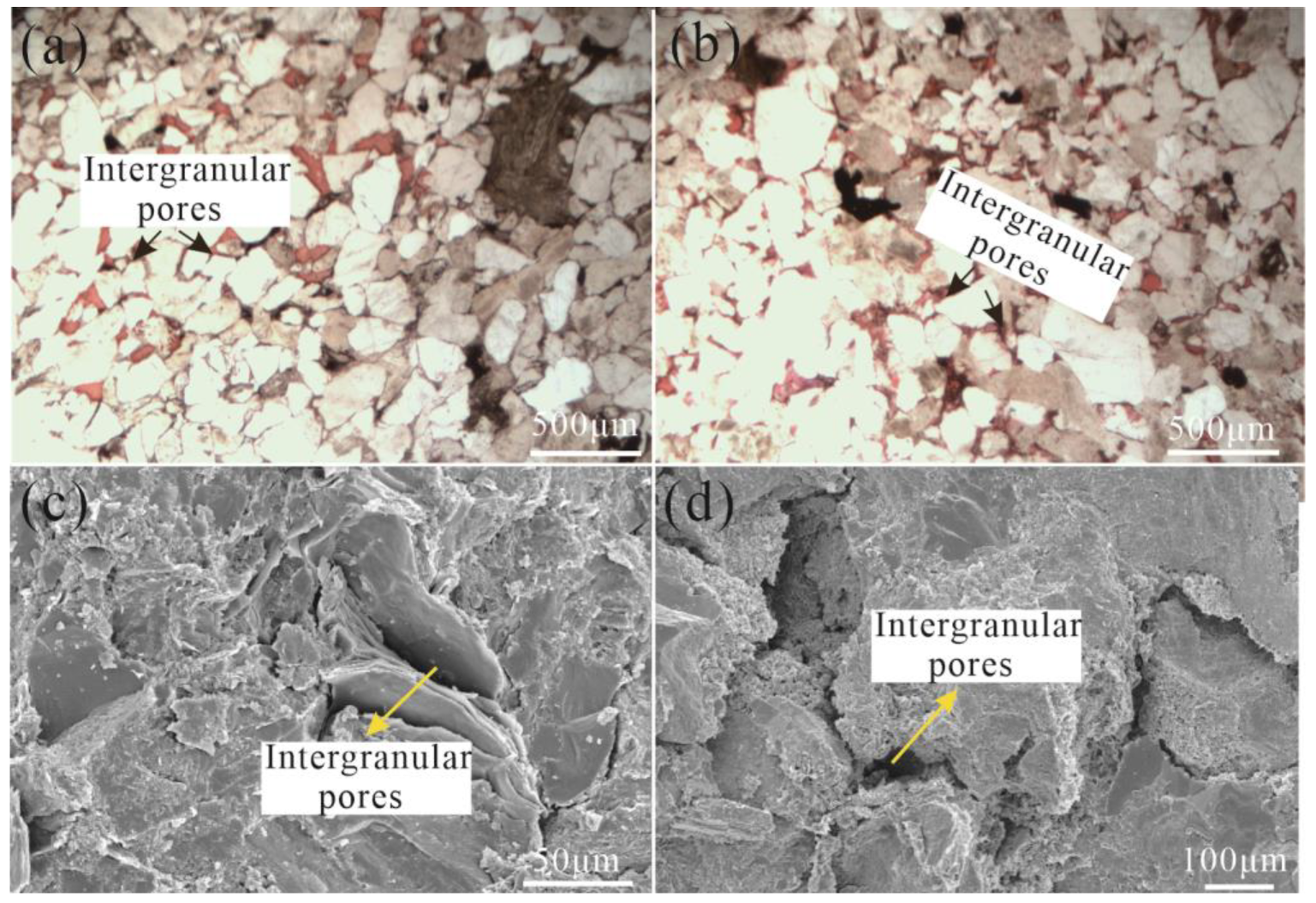
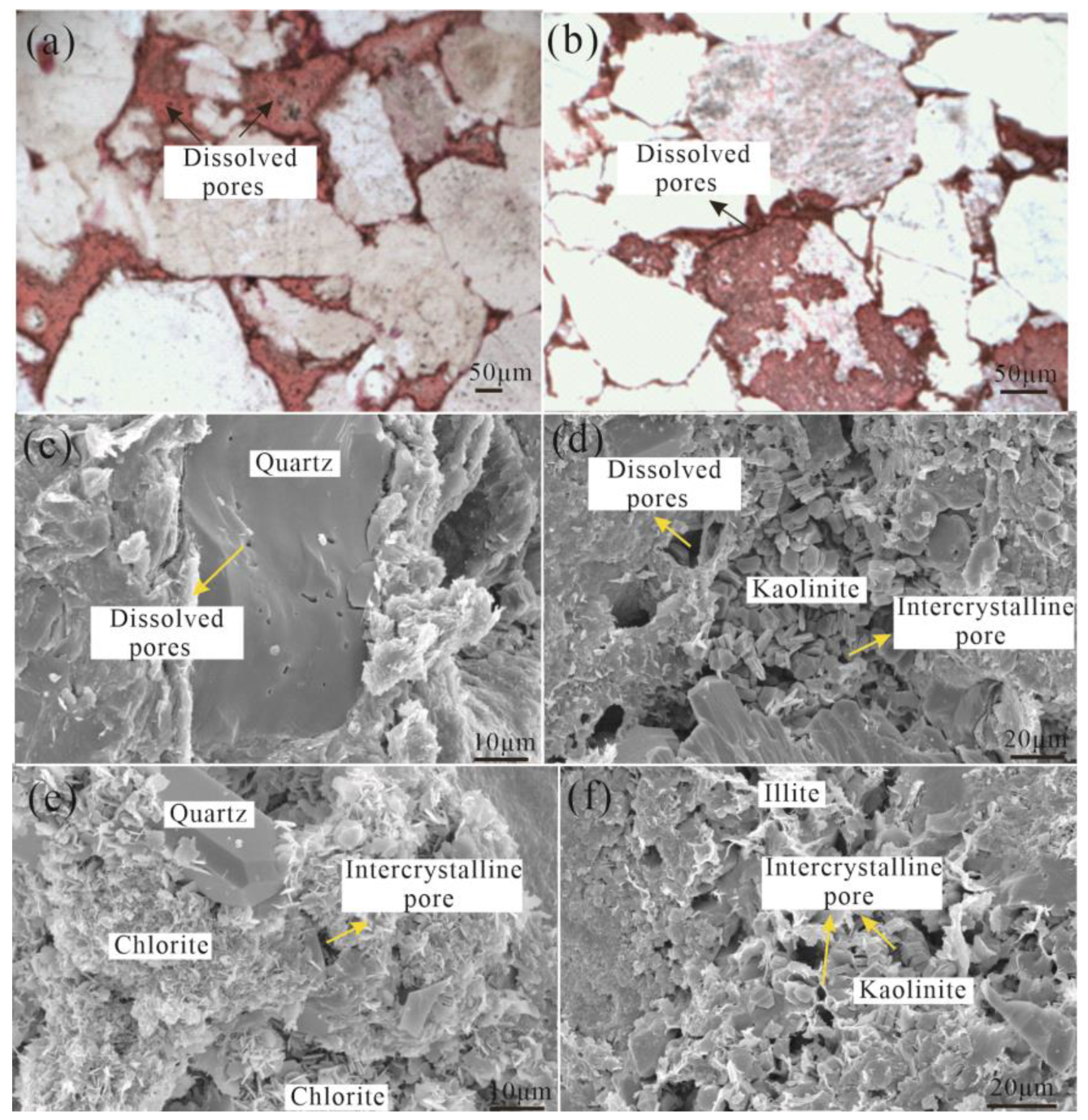
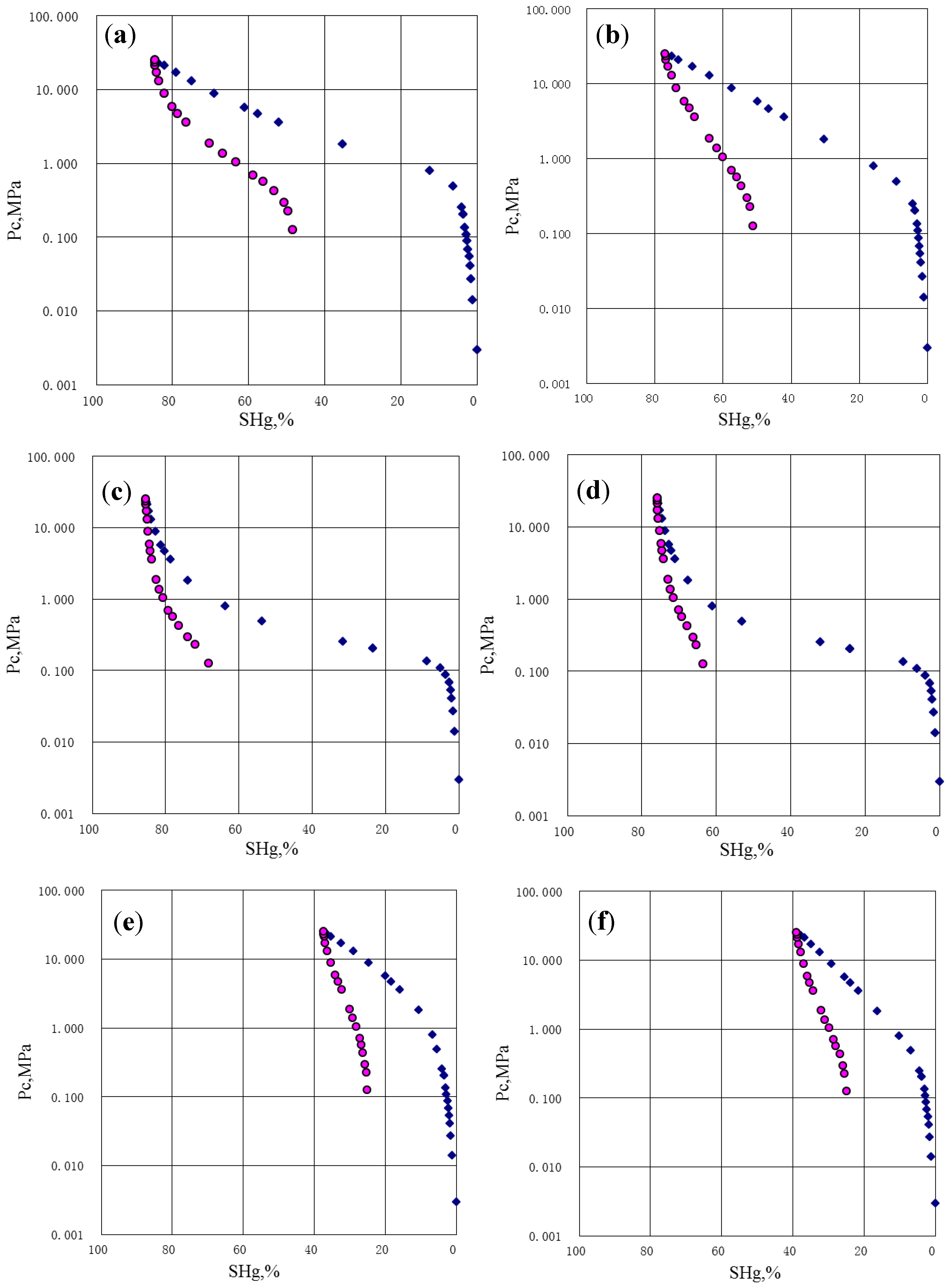


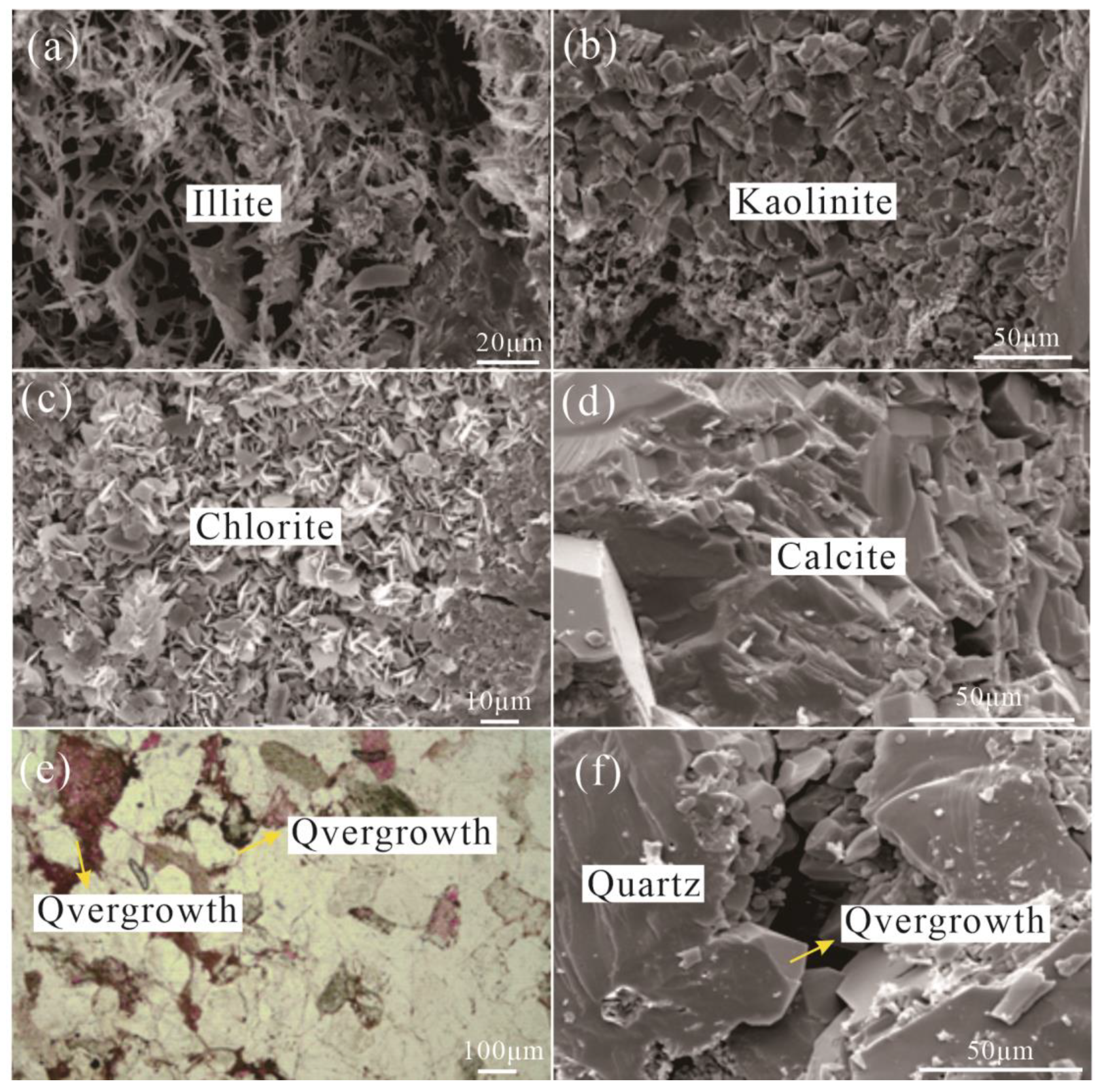

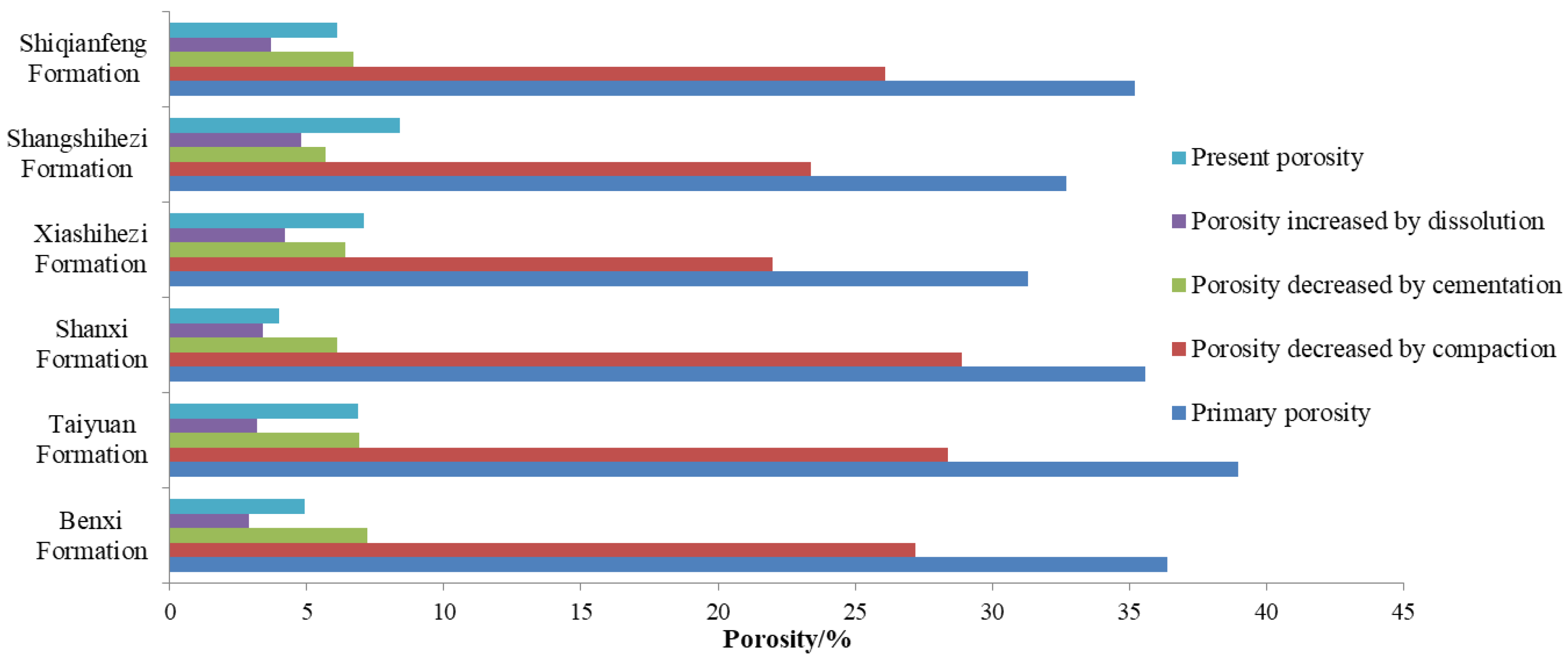
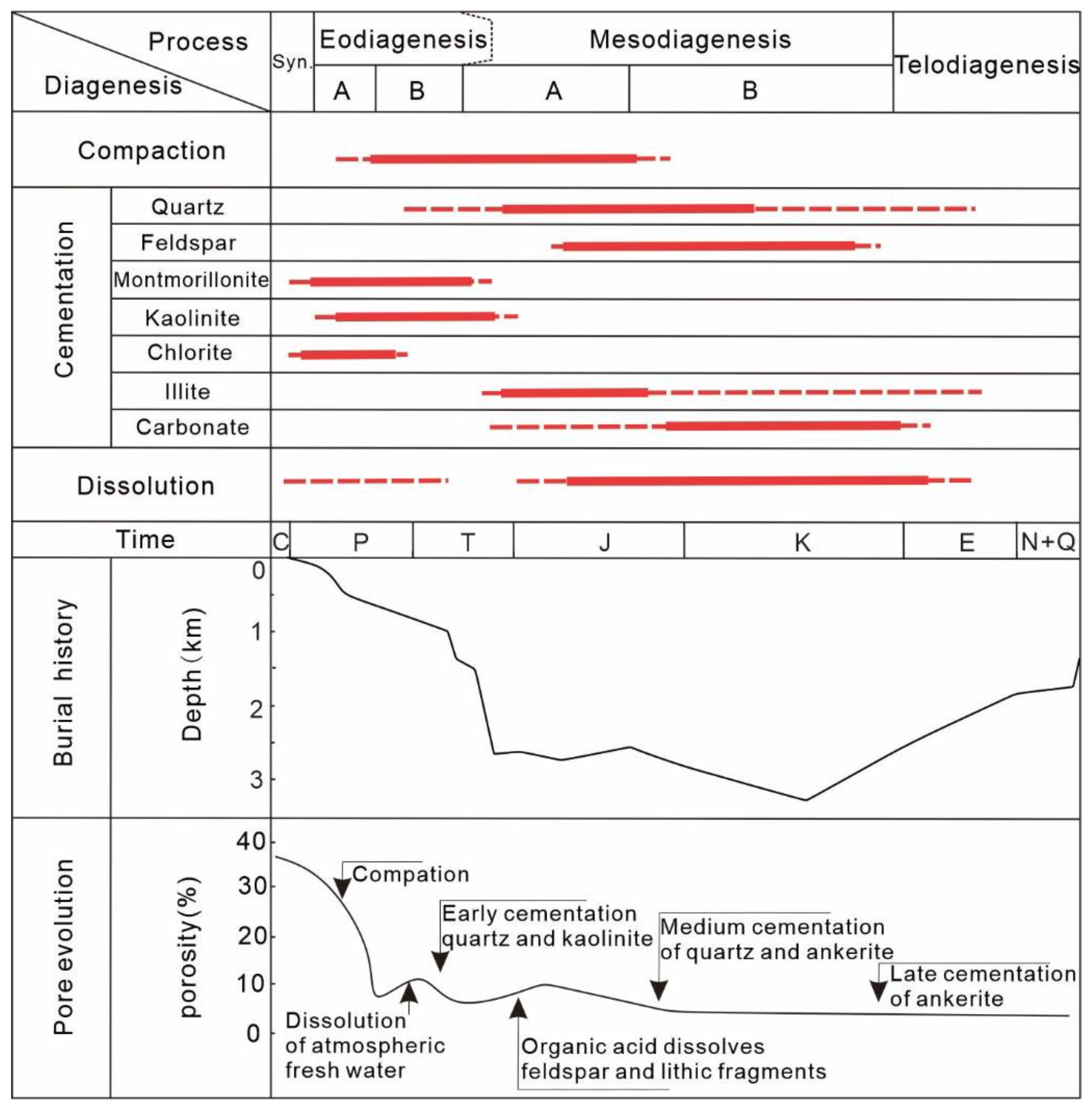

| Formation | Shangshihezi | Xiashihezi | Shanxi | Taiyuan | Benxi |
|---|---|---|---|---|---|
| Porosity/% | 8.4 (101) | 7.1 (94) | 3.99 (11) | 6.88 (2) | 4.9 (4) |
| Permeability/mD | 0.95 (97) | 0.29 (93) | 0.11 (11) | 0.77 (2) | 2.86 (4) |
| Pore Type | Sample ID | Formation | Sorting Coefficient | Structural Coefficient | Coefficient of Mean Value | Average Pore Throat Diameter/μm | Displacement Pressure/MPa | Maximum Mercury Saturation/% | Efficiency of Mercury Ejection/% | Porosity /% |
|---|---|---|---|---|---|---|---|---|---|---|
| I | S6-5 | Xiashi hezi | 2.89 | 3.25 | 0.16 | 0.97 | 0.23 | 69.03 | 37.59 | 3.1 |
| S6-18 | Xiashi hezi | 0.87 | 2.3 | 0.46 | 0.37 | 0.99 | 81.08 | 43.38 | 8.2 | |
| S6-19 | Xiashi hezi | 1.12 | 3.42 | 0.22 | 0.44 | 0.79 | 80.09 | 38.76 | 7.2 | |
| S7-6 | Xiashi hezi | 1.52 | 1.59 | 0.3 | 0.59 | 0.61 | 86.85 | 51.68 | 12.4 | |
| S7-7 | Xiashi hezi | 1.62 | 1.67 | 0.32 | 0.62 | 0.59 | 84.59 | 42.85 | 10.8 | |
| S1-2 | Xiashi hezi | 0.23 | 0.08 | / | 2.48 | 0.7 | 84.6 | 39.8 | 7.7 | |
| S1-3 | Xiashi hezi | 0.2 | 0.17 | / | 0.31 | 0.7 | 91.54 | 35.92 | 7 | |
| S1-4 | Xiashi hezi | 0.21 | 0.15 | / | 0.31 | 0.5 | 88 | 42.02 | 8.6 | |
| S2-22 | Shang shihezi | 0.21 | 0.13 | / | 0.33 | 0.3 | 86.89 | 46.63 | 16.8 | |
| S2-38 | Shang shihezi | 0.28 | 0.19 | / | 0.41 | 0.3 | 79.63 | 45.26 | 10.6 | |
| S2-47 | Shang shihezi | 0.26 | 0.03 | / | 0.48 | 0.3 | 84.33 | 35.91 | 13.8 | |
| Average | 0.86 | 1.18 | 0.29 | 0.66 | 0.55 | 83.33 | 41.8 | 9.65 | ||
| II | S12-44 | Tai yuan | 11.2 | 9.58 | 0.35 | 3.66 | 0.12 | 85.4 | 20.08 | 7.9 |
| S12-45 | Tai yuan | 13.2 | 14.5 | 0.32 | 4.26 | 0.11 | 75.89 | 16.19 | 8.4 | |
| S2-17 | Shang shihezi | 0.12 | 0.01 | / | 0.02 | 7 | 90.65 | 22.28 | 4 | |
| S2-30 | Shang shihezi | 0.2 | 0.2 | / | 0.38 | 0.5 | 86.69 | 30.17 | 12.2 | |
| S6-2 | Shanxi | 0.63 | 1.06 | 0.33 | 0.28 | 1.65 | 81.67 | 26.28 | 3.6 | |
| S12-13 | Shang shihezi | 2.2 | 5.09 | 0.24 | 0.77 | 0.38 | 76.89 | 33.41 | 9.9 | |
| S12-14 | Shang shihezi | 5.2 | 40.8 | 0.23 | 1.64 | 0.19 | 61.57 | 21.18 | 12.6 | |
| S1-1 | Xiashi hezi | 0.48 | 0.05 | / | 0.11 | 1 | 63.57 | 33.38 | 2.5 | |
| S2-9 | Shanxi | 0.52 | 0.1 | / | 0.17 | 0.8 | 62.45 | 31.29 | 4 | |
| S2-14 | Shanxi | 0.69 | 0.01 | / | 0.02 | 7 | 51.08 | 31.73 | 3.2 | |
| Average | 3.43 | 7.14 | 0.29 | 1.13 | 1.87 | 73.58 | 26.6 | 6.83 | ||
| III | S6-3 | Tai yuan | 0.52 | 1.04 | 0.39 | 0.27 | 1.12 | 37.42 | 32.92 | 3.2 |
| S6-4 | Tai yuan | 1.92 | 0.87 | 0.24 | 0.72 | 0.45 | 38.98 | 36.1 | 5.6 | |
| S6-9 | Tai yuan | 0.04 | 0.08 | 0.6 | 6.88 | 6.88 | 30.79 | 35.6 | 2.7 | |
| S2-2 | Tai yuan | 1.05 | 0.13 | / | 0.14 | 1.5 | 37.4 | 44.52 | 5.2 | |
| S2-52 | Xiashi hezi | 0.55 | 0.05 | / | 0.09 | 2 | 59.42 | 38.08 | 4 | |
| S2-62 | Xiashi hezi | 1.66 | 0.03 | / | 0.06 | 3 | 22.3 | 33.61 | 5.7 | |
| S2-67 | Xiashi hezi | 1.06 | 0.04 | / | 0.05 | 3 | 36.75 | 36.2 | 3.7 | |
| S2-75 | Xiashi hezi | 1.05 | 0.13 | / | 0.14 | 1.5 | 37.4 | 44.52 | 5.2 | |
| Average | 0.98 | 0.3 | 0.41 | 1.04 | 2.43 | 37.56 | 37.69 | 4.4 | ||
| Formation | Sedimentary Facies | Porosity (%) | Permeability (mD) | ||
|---|---|---|---|---|---|
| Range | Average | Range | Average | ||
| Shangshihezi | Delta Front | 0.51–15.34 | 8.4 | 0.06–2.31 | 0.95 |
| Xiashihezi | Delta Front | 0.23–14.34 | 7.1 | 0.04–0.79 | 0.29 |
| Shanxi | Distributary Channel | 1.43–5.89 | 3.99 | 0.007–0.45 | 0.11 |
| Taiyuan | Tidal Flat Lagoon | 4.56–9.2 | 6.88 | 0.002–3.64 | 0.77 |
Disclaimer/Publisher’s Note: The statements, opinions and data contained in all publications are solely those of the individual author(s) and contributor(s) and not of MDPI and/or the editor(s). MDPI and/or the editor(s) disclaim responsibility for any injury to people or property resulting from any ideas, methods, instructions or products referred to in the content. |
© 2023 by the authors. Licensee MDPI, Basel, Switzerland. This article is an open access article distributed under the terms and conditions of the Creative Commons Attribution (CC BY) license (https://creativecommons.org/licenses/by/4.0/).
Share and Cite
Wang, J.; Ye, F.; Zhang, C.; Xi, Z. Factors That Control the Reservoir Quality of the Carboniferous–Permian Tight Sandstones in the Shilounan Block, Ordos Basin. Processes 2023, 11, 2279. https://doi.org/10.3390/pr11082279
Wang J, Ye F, Zhang C, Xi Z. Factors That Control the Reservoir Quality of the Carboniferous–Permian Tight Sandstones in the Shilounan Block, Ordos Basin. Processes. 2023; 11(8):2279. https://doi.org/10.3390/pr11082279
Chicago/Turabian StyleWang, Jing, Fawang Ye, Chuan Zhang, and Zhaodong Xi. 2023. "Factors That Control the Reservoir Quality of the Carboniferous–Permian Tight Sandstones in the Shilounan Block, Ordos Basin" Processes 11, no. 8: 2279. https://doi.org/10.3390/pr11082279





